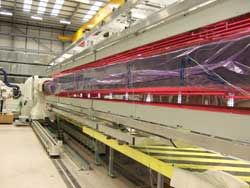Infrared Heating helps to ensure quality in the manufacture of composite structures for airplanes

Infrared heat helps to avoid wrinkling in aircraft structures. Copyright Heraeus Noblelight 2012<br>
The system, which is used to provide interim processing of the laid-up composite rear spar assembly of the Airbus 350 XWB to prevent subsequent wrinkling, was custom-designed and developed in close co-operation with GKN Aerospace engineers following initial tests at Heraeus’ Application Centre in Neston, Wirral.
GKN Aerospace is a world-leading, global first tier supplier of airframe and engine structures, components and assemblies to a wide range of aircraft and engine prime contractors and other first tier suppliers. It has invested £170 million to create its new composite wing structures manufacturing and assembly facility, which represents an international centre of excellence.
The new “Western Approach” site consists of two main buildings. The first contains a state-of-the-art composites manufacturing operation that incorporates the latest, automated high-speed, precision production technologies. The second building houses an innovative and “moving line” assembly operation that uses automated, guided vehicles to move the wing structures through a series of semi-robotic work stations.
An important work package already underway at the site is the manufacture of the all-composite rear wing spars for the Airbus A350 XWB. Each of the three rear wing spars is manufactured by laying up pre-preg carbon composite tape on a mandrel and then curing the assembly in an autoclave. However, such complex lay down operations can sometimes produce wrinkling of the final surface because of voids and excess resin between plies or laminates. One proven answer to this problem is de-bulking, which involves enclosing the composite structure in a vacuum bag at various stages in its manufacture and then compacting or squeezing out of air and volatiles between plies or pre-preg laminates under moderate heat and vacuum to insure seating on the mandrel, to prevent wrinkles, and to promote adhesion.
GKN Aerospace’s engineers decided that de-bulking could provide significant benefits and asked Heraeus to carry out initial trials using infrared emitters to provide the required heat. These were followed by on-site trials using a portable infrared system at Western Approach and these were so successful that a prototype system was supplied.
The prototype system was finally replaced by a scaled-up 465 kW production system, where each of the three heating sections now has seven controllable zones to provide precise surface heating.
Heraeus, the precious metals and technology group headquartered in Hanau, Germany, is a global, private company with more than 160 years of tradition. Our fields of competence include precious metals, materials, and technologies, sensors, biomaterials, and medical products, as well as dental products, quartz glass, and specialty light sources. With product revenues of €4.8 billion and precious metal trading revenues of €21.3 billion, as well as more than 13,300 employees in over 120 subsidiaries worldwide, Heraeus holds a leading position in its global markets.
Heraeus Noblelight GmbH with its headquarters in Hanau and with subsidiaries in the USA, Great Britain, France, China and Australia, is one of the technology- and market-leaders in the production of specialist light sources. In 2011, Heraeus Noblelight had an annual turnover of 103 Million € and employed 731 people worldwide. The organization develops, manufactures and markets infrared and ultraviolet emitters for applications in industrial manufacture, environmental protection, medicine and cosmetics, research, development and analytical measurement techniques.
For further information, please contact:
Technical:
Heraeus Noblelight GmbH
Reinhard-Heraeus-Ring 7
D-63801 Kleinostheim
Tel +49 6181/35-8545, Fax +49 6181/35-16 8545
E-Mail hng-infrared@heraeus.com
Press:
Dr. Marie-Luise Bopp
Heraeus Noblelight GmbH,
Abteilung Marketing/Werbung
Tel +49 6181/35-8547, Fax +49 6181/35-16 8547
E-Mail marie-luise.bopp@heraeus.com
Media Contact
All latest news from the category: Process Engineering
This special field revolves around processes for modifying material properties (milling, cooling), composition (filtration, distillation) and type (oxidation, hydration).
Valuable information is available on a broad range of technologies including material separation, laser processes, measuring techniques and robot engineering in addition to testing methods and coating and materials analysis processes.
Newest articles

Recovering phosphorus from sewage sludge ash
Chemical and heat treatment of sewage sludge can recover phosphorus in a process that could help address the problem of diminishing supplies of phosphorus ores. Valuable supplies of phosphorus could…

Efficient, sustainable and cost-effective hybrid energy storage system for modern power grids
EU project HyFlow: Over three years of research, the consortium of the EU project HyFlow has successfully developed a highly efficient, sustainable, and cost-effective hybrid energy storage system (HESS) that…

After 25 years, researchers uncover genetic cause of rare neurological disease
Some families call it a trial of faith. Others just call it a curse. The progressive neurological disease known as spinocerebellar ataxia 4 (SCA4) is a rare condition, but its…





















